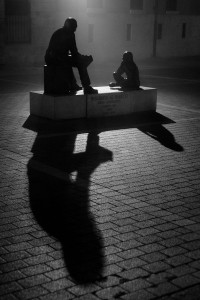
With so much focus these days on improving learning environments, utilizing new technologies which enable students to interact more effectively with each other and their teachers, and various methods of implementing student- and project-centered learning, it almost feels old-fashioned to talk about teachers. But my road to the Teachers’ Academy was paved by my best teachers. All were passionate about their subjects, and made us want to learn. But in hindsight, I’ve noticed that each also taught me a slightly different skill about teaching which I have found extremely valuable in my own classrooms.
Knowledge is created when questions are asked and answered, and I think most teachers take great care when thinking about the questions they present to a class. But rarely have I met a teacher who listened as intently and compassionately as Achsah Guibbory. Guibbory seemed to regard every student comment as a gift to be cherished. She looked you in the eye when you spoke, her own brown eyes sparkling. Because she listened so intently, she could refer back to previous contributors by name when discussing other people’s comments; it was like a double gift, to be listened to and quoted. She also had the extraordinary ability to disagree with you without making you feel bad about yourself.
I think about Guibbory especially in translation classes, when I thank students who have had the courage to share one of their weaker solutions with the class so we can discuss various ways of improving it. And while I do look students in the eye when they speak (and nod my head, as Americans are wont to do), I’m happiest when they look at each other instead of me, as I suspect Guibbory was too.
Nowadays there is much talk of activating students in the classroom, but I have learned equally well from both “passive” listening and hands-on exercises. I remember vividly two literature teachers who taught by reciting: Gary Adelman, who had memorized practically the entire syllabus of British Literature, and thrilled us with his performances of Blake’s “The Sick Rose,” Keats’ “Ode to a Nightingale,” and many others. Adelman made us memorize poems, and I can still recite much of what I learned then.
Much less fiery, but no less intense, was Arnold Stein, who taught Milton by sitting on his desk at the front of the room, paging thoughtfully through the text, and reading aloud the best bits. His sonorous baritone was much like I imagined Milton’s voice might have sounded. Every now and again, Stein broke off to clarify a difficult interpretive point, or tell a joke, the wrinkles at the corners of his eyes confirming that he smiled often.
It was my Shakespeare teachers—Michael Mullin and Michael Shapiro—who made us perform texts ourselves. Oh how we used to laugh! And argue: over interpretation, blocking, delivery, costumes, all the things you can argue about when everything comes out of your imagination and your closet. And when I watch my students perform, in some cases needing first to conquer considerable fear, I marvel at their inventiveness, their insight. Thanks to Teachers’ Academy funding, I am now teaching a new class on ways of incorporating drama into foreign language teaching, and hope that down the road drama exercises in schools will positively impact language fluency and skills.
Perhaps the most crucial skills we teach at the university are research and writing, and the teacher who has most shaped my approach to teaching these was Nina Baym. Her reputation preceded her: she seemed to have read everything and published on most of it. I took her Introduction to American Literature early in my studies, so she was the first scholar I heard discussing her own writing process: the hours in the library, the number of drafts. She made it clear that she had high standards, but she also promised that we could re-write our papers as often as we wanted; she would provide feedback. I rewrote every paper in that course, some more than once. The grades steadily improved.
Since then, I’ve read a great deal on process writing, and normally require some kind of process-written paper in my courses. I talk openly with students about writer’s block, about problems and possible solutions. I try to find out what individual students need: many need to be coaxed into sharing what they think is a terrible draft which turns out to be quite good; others are more able to share work in progress. As a class we work on learning how to give and receive feedback, to make our writing sharper and more effective. None of this is easy, especially in a foreign language where the expectation is that students will graduate as near native-speakers.
From these teachers, I have learned to listen, to entertain and activate in equal measure, and to ask my students to revise, revise, revise. The payoffs come in small moments: a satisfied smile; rows of eyes and ears hanging on to the last word; proud bows to spirited applause; and the master’s student about to hand in her thesis who thanked me last week for challenging her to write her very best.
Nely Keinänen
The author is a university lecturer in English philology and a member of the Teachers’ Academy.
